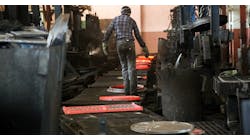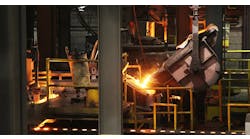No-Code Robot Interfacing
Download: 2025 Metalcasting Outlook
A Few Words Before We Continue
Executive Change at Inductotherm
In 1956, the General Motors Technical Center represented an optimistic and stylish claim on the future of industrial progress – and still does today.
The General Motors Technical Center in Warren, MI, is a research center developed by the automaker beginning in 1949, and completed in 1955 at a cost of approximately $100 million. President Dwight D. Eisenhower officiated at the inaugural event in 1956. The latest inductee to the FM&T Hall of Honor, Alan P. Druschitz, Ph.D., spent much of the 1980s there, researching metalcasting processes.
The campus covers 330 acres and has 11 miles of roads and 1.1 miles of tunnels connecting 25 main buildings, with numerous other structures and 22-acre lake.
GM was not the first or only corporation to concentrate its research efforts: Other giants of the 20th Century like General Electric and International Business Machines also purpose-built campuses where new products could be conceived, designed, tested, and developed. Likewise, design and production problems could be re-examined and addressed.
Over the years, the GM Technical Center has embraced a wide range of subject areas – not just automotive design but the technologies and disciplines that relate to it: physics and chemistry, materials science and metallurgy, electronics and energy systems, adhesives, forming, joining technologies, communications systems, and many more.
Just as notable, from the start the GM Technical Center has been a showplace of architectural and landscape design. Its primary designer was Eero Saarinen, a master of Mid-Century Modern art and architecture, the second wave of Modernism that fused the original concept of “form following function” with more sculptural forms, as well as more whimsical and futuristic expressions of post-War optimism, and importantly, more humanistic gestures that signified individuals were welcome in this mechanized environment -- indeed, were central to its design. Saarinen's concepts as displayed at the GM campus reveal a stylized landscape and architecture that is in the service of human civilization.
GM wanted the Technical Center to be a community too, a place of scientific and industrial progress, staffed with thousands of intellects and technical experts, sharing workspace, projects, seminars and tutorials, even lunch in a central cafeteria.
Today, the Tech Center has about 19,000 workers — engineers, designers, technicians, and others — working on new product development, design, information technology, R&D and customer service.
Saarinen’s work at the GM Technical Center was later cited as the most outstanding architectural project of its era by the American Institute of Architects.








